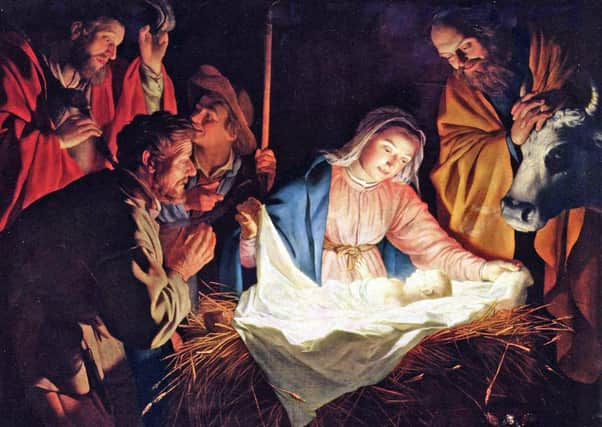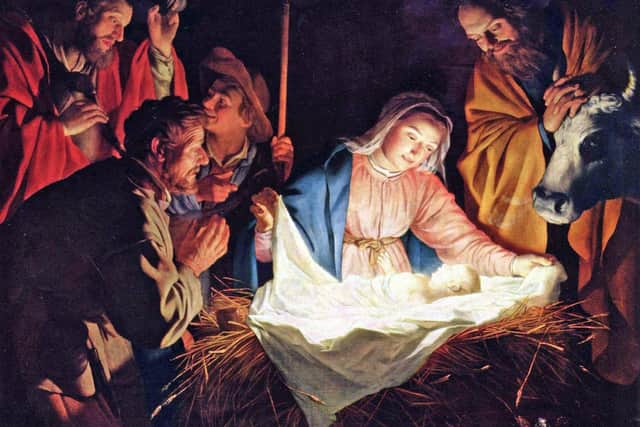The Novena to the Divine Child from Termonbacca next week


Background and History of the Novena
The novena to the Divine Child or to the Infant Jesus has a long tradition dating back centuries in many countries throughout the world. The religious images can be traced back to the fourteenth century in Europe. There are several depictions in paintings and statue form venerated in many Churches throughout the World. Over many years devotion and veneration for personal communal veneration has taken various forms.
Probably one of best known in Europe and Ireland is the devotion to the Infant Child Jesus of Prague. In many Irish homes, you will find a statue of the ‘Child of Prague’. Indeed many Irish homes will place the statue in a prominent window and facing outside for protection of the home and all those who live there. A tradition, still very much prevalent in Ireland, even to this day, is to place it outside in the garden, on the eve of a bride’s wedding day, and pray for protection from inclement weather on the wedding day. Many devotions to the infant Child Jesus will focus on protection from harm of one sort or another.
Advertisement
Hide AdAdvertisement
Hide Ad

The image of the infant Christ Child has widespread appeal among many Catholic people. It is a very visible and physical reminder of what Christmas is all about – the incarnation – Emmanuel, God is with us. It was, and is, very much a family orientated novena. The devotion, in the past, was often passed down through families, particularly the devotion to ‘El Divino Nino’ (The Divine Child). This novena originated in Bogota, Columbia in 1914 where the Christ Child appeared to a Father Rizzo, a Catholic priest of the Salesian order and where the devotion became associated with children and the poor.
It is recorded that El Divino Nino (The Christ Child) appeared to Mother Angelica during her mission to Colombia in an effort to expand the Eternal Word Television Network. She returned to the United States and eventually built the Shrine of the Most Blessed Sacrament as a devotion to El Divino Nino. She later explained in interviews that the miracle of the apparition inspired her to build the shrine as a devotion for women and specifically to end the scourge of child abuse.
The Carmelite Tradition
The Carmelite Order has a rich tradition of devotion to the Child Jesus and can trace their beginnings back to the hermits that lived on Mount Carmel. The Carmelite Marian tradition had an original oratory on Mount Carmel that was devoted to Mary. The original hermits became known as the Brothers of Saint Mary from Mount Carmel. The patroness of the Carmelite Order is our Lady of Mount Carmel, a title given to the Blessed Virgin Mary.
Later, when the Carmelites spread out in Europe, they carried the devotion to the Divine Child everywhere. In 1200, Saint Anthony of Padua, and in 1500 Saint Cajetan had great devotion to the Child Jesus, and because of that, there is a painting of each saint carrying the Divine Child in his arms. But those who most popularized the devotion to the Divine Child Jesus were Saint Therese of the Child Jesus and the Holy Face, known popularly as Saint Therese of Lisieux, St Teresa of Avila and Saint John of the Cross.
Advertisement
Hide AdAdvertisement
Hide AdWhen she was novice mistress in Lisieux, Saint Therese placed a Child of Prague statue in the novitiate because she knew of the many blessings the Divine Child brought to the Carmelite novices in Prague, when it was placed in their midst. Tradition has it that Saint Teresa of Avila also had a personal devotion to the infant Jesus of Prague.
From Saint Teresa, we are told, that as she was climbing some steps towards a corridor, she saw the Child Jesus who greeted her kindly. Since then, the saint always carried with her on her travels, a statue of the Divine Child, and in all the homes of her order, she asked that a picture of the Child Jesus be placed and honoured. She almost always left one as a present.
There is wooden statue of the Child Jesus in the Discalced Carmelite Church of Our Lady Victorious in Prague city that is reputed to have belonged to St. Teresa of Avila. Pope Benedict XVI crowned that image, for only the second time, during his Apostolic visit to the Czech Republic on September 26th 2009.
The discalced Carmelite Order, following the example of their founding saints, Saint Teresa of Avila and Saint John of the Cross, have made the point of explaining that the devotion to the infant Child Jesus is not the belief that an image made of plaster, metal or wood, will perform a miracle for us, because images cannot work miracles for anyone. It is an image that helps us call to mind and to honour the first hidden twelve years of Jesus’ life on Earth, His childhood years, and to draw from the merits that Jesus gained during his twelve years of childhood by asking the Divine Child to help us. It is a novena particularly focused on families and young people.
Advertisement
Hide AdAdvertisement
Hide AdIn 1636, Our Lord made a promise to Venerable Marguerite of the Most Holy Sacrament that became famous: “Everything that you want to ask for, ask for it through the merits of my childhood and your prayer will be heard”.
In many Carmelite monasteries or convents, an old tradition grew up of placing the image of the infant Child Jesus that would be placed in the crib at Christmas, in a nun or monk’s cell for one night. This was part of a nine day novena, during which, they prayed and venerated the infant Child Jesus, reminding themselves of the whole purpose of the incarnation was ‘the word becoming flesh and living among us (John 1:4). It was that Child who went to the Cross for each and every one of us. Emmanuel, God had pitched His tent among us.
Following on, somewhat, from those rich associations and traditions of the order, the discalced Carmelites in Termonbacca, Derry, are this year instituting a Novena to the Divine Child. The novena will run from 15th to 23rd December. The novena Mass and prayers will be streamed live from Termonbacca at 7:30 pm each evening and copies of the novena prayers will be available on the Termonbacca Facebook page and from Termonbacca itself.
It somehow seems rather fitting, that this novena with its strong emphasis on protection from harm, the family and young people, has been introduced this pandemic year. A year that will never be forgotten, because of the social upheaval and disruption, harm, havoc, serious illness and death, caused by the Covid-19 virus. Many people’s lives and livelihoods have suffered quite badly and been seriously impacted by the consequences of this once in a lifetime event. Joy might be in short supply this Christmas time.
Advertisement
Hide AdAdvertisement
Hide AdThe novena to the Divine Child unashamedly highlights the real meaning of Christmas - that Christ has come among us. It presents for us all, as believing Christians, an opportunity to be still and ponder the incarnation and what that event means to us today. It provides time for personal and family prayer and allows us to refocus our attention on the Christ Child, the nature of His coming, (born in a byre) and importantly why He came. The answer to that question is provided in the gospel of John, “Yes, God loved the world so much that he gave his only Son, so that everyone who believes in him may not be lost but may have eternal life.” (John 3:16) As Christians, perhaps we are in need of a change of mindset that opposes the world view that has almost eliminated the birth of the Christ Child from Christmas. However, it most certainly is an occasion for Christians to exclaim with great joy, as the angel told the shepherds “that a saviour has been born to us; He is Christ the Lord”. (Luke 2:10-11)
This novena will have a unique aspect to it, mirroring the Carmelite tradition of housing the image of the Child Jesus in a nun or monk’s cell prior to it being installed in the crib. The image of the infant Child Jesus will be carried to nine different homes, in nine different local areas throughout the Derry area, by an escort of volunteers. It will stay overnight in these homes each day of the novena. This journey in many ways will also call to mind the journey of Mary and Joseph to Bethlehem to be counted in the census, a journey of some 90miles.
Novena Masses
The novena itself will comprise of nine evening Masses at 7:30pm (from 15th -23rdDec.) celebrated by the Carmelite Fathers and followed by the public novena prayers and streamed live from Termonbacca Monastery, each evening. Prior to the Christmas Eve vigil Mass at 11pm the image will be installed in the crib. Everyone is encouraged to take part and join in the Mass and devotional prayers, placing their daily intentions before the Christ Child.
The Termonbacca evening vigil Christmas Eve Mass will be streamed live on the Termonbacca Facebook/Youtube.
Advertisement
Hide AdAdvertisement
Hide AdWhile there is an emphasis on the protection of families and young people during the novena, everyone, who can, is invited to join along with Carmelite Fathers in Termonbacca in this first novena to the Divine Child. Whether you are taking part or not, perhaps only occasionally, the Carmelite Fathers are encouraging that old Christian tradition of placing a lighted candle in the window of homes in Derry for the entire nine nights, as a sign of hope in the midst of this Pandemic and as a welcome of the infant Child Jesus into your homes this Christmas. They are also encouraging those taking part to erect and display a crib prominently in their homes.
Novena prayers will be available from Termonbacca or by going into the Termonbacca Facebook page or emailing [email protected] or for those living close simply calling up to Termonbacca and collecting them. Please note if doing so, masks will need to be worn before entering the Monastery.